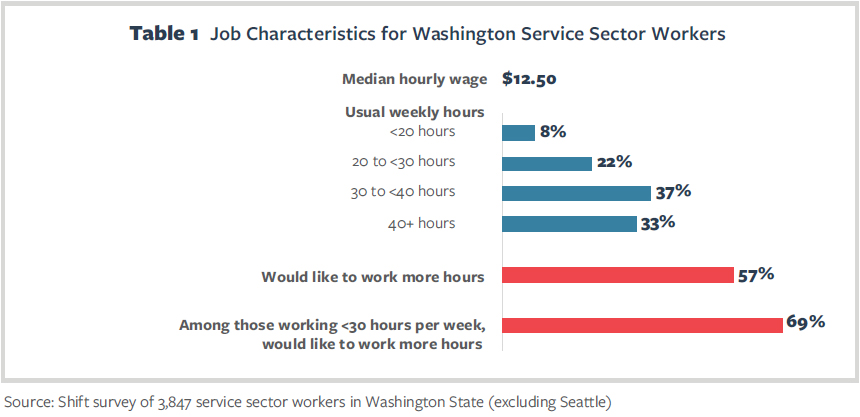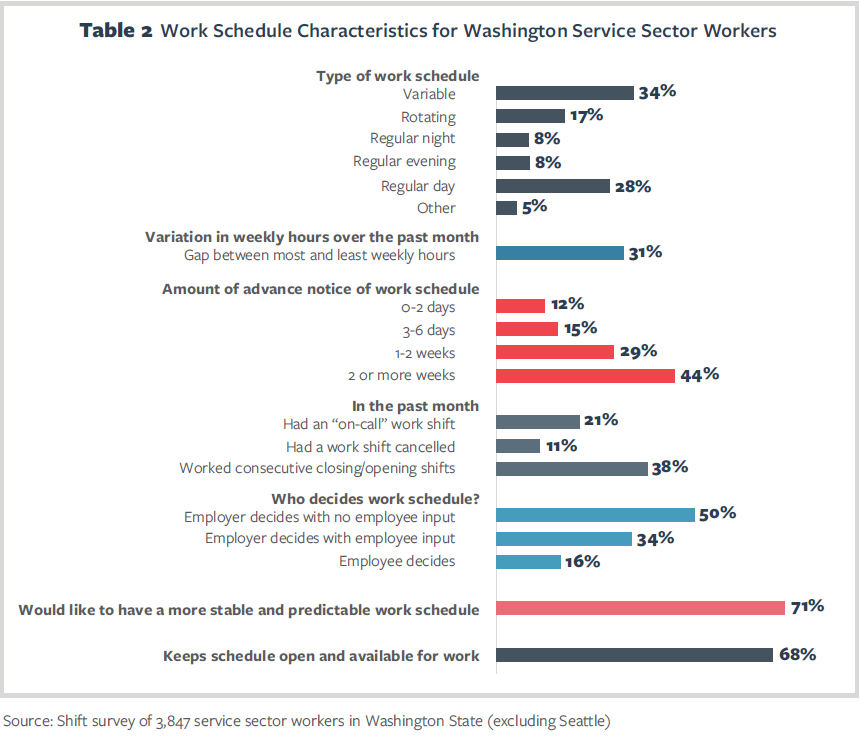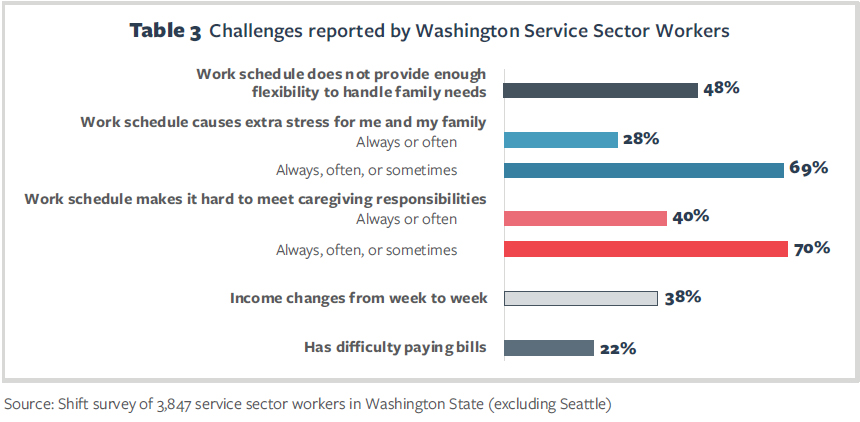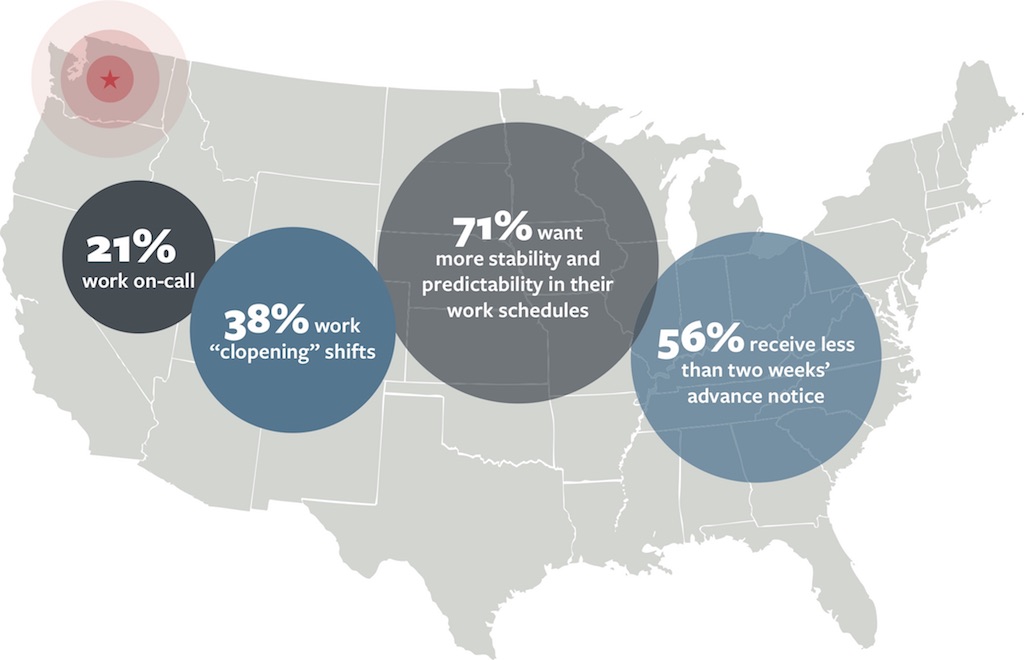Service sector jobs in the United States are characterized by low pay, few fringe benefits, and limited employee control over scheduled work days and times.1 Many service sector employers across the country rely on just-in-time and on-call scheduling practices designed to minimize labor costs by closely aligning staffing with consumer demand.2 These practices can introduce significant instability into the lives of workers and their families.3
This research brief is part of a series designed to advance our understanding of working conditions in the service sector – in particular, schedule instability and unpredictability – in cities and states across the country. Since 2016, The Shift Project has collected survey data from workers employed at large chain retailers and food service establishments.4 We ask respondents about their work schedules, household economic security, health, and wellbeing, targeting employees at large firms that are the focus of recent state and local labor regulation efforts. Our data permit an unprecedented view of labor conditions in the service sector and provide unparalleled insight into the work and family lives of low-wage workers.
Over 475,000 people are employed in the retail and food service sectors in the state of Washington.5 This brief describes the experiences reported by 3,847 of these workers. We exclude data from the city of Seattle, which implemented scheduling regulations in 2017, in order to capture the experiences and working conditions of Washingtonians who are not currently covered by secure scheduling laws.6
Wages and Work Hours
In Washington, the minimum wage is currently $11.50 – substantially higher than the $7.25 federal minimum wage – and the estimated hourly living wage for a single individual with no children is around $12.00.7 Yet, nearly half of Washington service sector workers in our sample (which covers the 2016-2018 period) report earning less than $12.00 per hour. Futhermore, the living wage estimate provided here assumes year-round full-time employment, an assumption that applies to a minority of Washington service sector workers. In fact, only a third of Washington workers report usually working at least 40 hours per week. The rest usually work part-time: 37% report working between 30 and less than 40 hours per week, 22% usually work between 20 and less than 30 hours, and 8% work fewer than 20 hours per week.
What do workers want? Some suggest that workers may prefer this part-time employment model. We tested this explanation directly by asking workers whether they “would like to work more hours” and found that over half – 57% of Washington workers overall, and 69% among those working fewer than 30 hours per week – reported that they would like to work more hours.
Unstable and Unpredictable Work Schedules
In addition to widespread part-time scheduling, we also find that Washington workers experience unstable and unpredictable work schedules, which manifest along several dimensions.
Nearly three-quarters of the workers in our sample report work schedules that are irregular or nonstandard: 34% report “variable” schedules, 17% report “rotating” schedules, and another 16% report regularly working night or evening shifts. Only 28% of service sector workers report a regular daytime work schedule.
We also asked workers whether they had experienced certain workforce management practices associated with scheduling instability in the past month. Twenty-one percent of workers reported working an “on-call” work shift, meaning that they kept their schedule open and available for work but may or may not actually have been called in to work the shift. Eleven percent of workers reported having a shift cancelled in the past month. Thirty-eight percent of workers reported working consecutive closing then opening shifts, referred to as “clopening.”
Washington workers also experience a great deal of variation in the total number of hours worked each week. When asked about their work schedule over the past month, the average worker reported a difference of 11 hours between the week they worked the most hours and the week they worked the fewest hours. In percentage terms, that is a 31% gap between the hours worked in the week with the most hours and that with the fewest. Given our focus on workers who are paid hourly, we know these variations in hours lead to volatility in earnings.
In addition to the common experience of schedule instability, many workers receive limited advance notice of their work schedules. Only 44% of workers receive more than 2 weeks’ advance notice of their work schedules. Another 29% receive between 1 and 2 weeks’ notice. The remaining 27% of workers receive less than 1 week’s advance notice; of those, nearly half receive no more than 2 days’ notice.
These measures show that many Washington service sector workers experience unstable and unpredictable work schedules. We also find that these workers often do not have control over their schedules. Half of workers have no input when it comes to setting their work schedules, 34% have some input, and only 16% of workers have a large degree of control over their scheduled work days and times.
Compounding all of these dimensions of scheduling instability, most workers reported that even in their personal time, they have to keep their schedule open and available for work. A striking 68% of workers reported that they keep their schedule open and make themselves available even when they are not scheduled to work. This has implications for their ability to balance work and family responsibilities, to combine work with schooling or other pursuits, and to achieve a work-life balance.
What do workers want? There is an unmet desire for more schedule stability and predictability among a large majority of Washington workers. When asked their preference, 71% of workers said that they “would like to have a more stable and predictable work schedule.” This share was even higher among Washington workers who reported a variable schedule (85% of those workers) or workers who reported working on-call shifts in the prior month (84% of those workers).
Challenges Reported by Washington Workers
Given the constellation of unstable and unpredictable scheduling practices experienced by Washington service sector workers in our sample, it is not surprising that many of these workers report that their work schedule interferes with their family needs and caregiving responsibilities. Half of workers express that their work schedule does not provide enough flexibility for them to handle family needs. More than a quarter of workers say that their work schedule is a chronic source of extra stress for their family and 69% say that their work schedule sometimes, often, or always causes extra stress. Forty percent say that their work schedule always or often makes it hard to meet their caregiving responsibilities, and an even larger share (70%) sometimes, often, or always experience conflicts between work and their caregiving responsibilities.
Another consequence of unstable work hours is unstable earnings and accompanying financial challenges. Thirty-eight percent of workers report that their income changes from week to week, and 22% report that they have difficulty paying their bills.
The Relationship Between Work Schedules and Worker Health and Hardship
Exposure to unstable and unpredictable schedules may also negatively affect workers’ health and wellbeing. For example, short notice and lastminute schedule changes may lead to economic instability for workers and may also increase work-life conflict, while lack of certainty about one’s schedule may be an added source of stress. In this section, we examine how the work schedules of Washington workers are related to health and hardship, and use our observations to make comparisons between workers with predictable schedules and those with unpredictable schedules. Workers with the most predictable schedules had at least two weeks’ advance notice of their schedules, did not work on-call in the last month, and did not have a cancelled shift in the last month. Workers with the least predictable schedules received less advance notice, worked on-call, and experienced at least one cancelled shift. Comparing these two groups of workers, we find that:
- Workers with unpredictable work schedules are much more likely to report having experienced hunger hardship in the past year. Our survey asked all workers, “In the past 12 months, were you ever hungry, but didn’t eat because you couldn’t afford enough food?” Twenty percent of Washington workers with predictable schedules experienced hunger in the past year, compared to 39% of workers with unpredictable schedules.
- Workers with unpredictable work schedules report worse sleep quality. Thirty-five percent of Washington workers with predictable schedules report good or very good sleep quality, compared
to only 15% of workers with unpredictable work schedules. - Workers with unpredictable work schedules are less happy. Eighty-two percent of Washington workers with predictable schedules report being happy overall, compared to 56% of workers with
unpredictable work schedules. - Workers with unpredictable work schedules are significantly more distressed. We asked workers how often they felt each of six types of distress in the past month (sadness, nervousness,
restlessness, hopelessness, that everything was an effort, and that difficulties were piling up high). The average Washington worker with a predictable work schedule reported each type of distress “a little” or “some of the time,” while workers with unpredictable schedules experienced more prevalent distress, on average reporting each type of distress “some” or “most of the time.” Overall, workers with unpredictable schedules scored 50% higher on the distress scale than those with predictable schedules.8
Discussion
The Shift Project’s survey of service sector workers provides a window into the experiences of workers employed at large retail and food establishments across the nation and in particular locales. This brief describes the experiences of workers in Washington State who work outside of Seattle and thus are not covered by Seattle’s Secure Scheduling Ordinance.
The portrait of Washington service sector workers reveals that unstable and unpredictable schedules are commonplace. As we have seen nationally, the retail and food sectors in Washington are characterized by low pay, insufficient work hours, and a lack of control over scheduled work hours. With the Shift data, we can also see in detail how these workers also contend with schedules that are announced with little notice and that are often changed at the last minute. By hearing directly from workers, we can learn not only about their experiences, but about their preferences. The majority of workers express a desire for more work hours and more predictability in their work schedules.
Scheduling practices are beginning to change, however, as some localities have passed labor laws that regulate work schedules. The state of Oregon, New York City, Seattle, San Francisco, and Emeryville (CA) have all passed legislation or implemented regulations requiring a certain amount of advance notice of work schedules (usually two weeks) and stipulating that workers be compensated by employers when their shifts are changed on shorter notice. Many of these new labor regulations also include an “access to hours” provision, requiring that employers offer additional hours to their part-time workers before hiring additional part-time employees.
There is currently no law in the state of Washington that explicitly regulates scheduling practices for hourly service sector workers employed outside of Seattle city limits. In this context, our data reveal that scheduling practices such as short advance notice and last-minute scheduling changes are a common experience for Washington workers. We document workers’ desire for more stable schedules, and find strong relationships between unstable schedules and undesirable outcomes such as hunger and poor sleep quality.



Endnotes
- Lambert, S. J. 2008. “Passing the Buck: Labor Flexibility Practices that Transfer Risk onto Hourly Workers.” Human Relations 61(9): 1203-1227.
- Golden, L. 2015. “Irregular Work Scheduling and Its Consequences.” Briefing Paper #394. Economic Policy Institute; Appelbaum, E., A. Bernhardt, and R. J. Murnane. (Eds.). 2003. Low-Wage America: How Employers are Reshaping Opportunity in the Workplace. New York: Russell Sage Foundation; Clawson, D., and N. Gerstel. 2015. Unequal Time: Gender, Class, and Family in Employment Schedules. New York: Russell Sage Foundation.
- Lambert, S.J., P. Fugiel, and J. R. Henly. 2014. Precarious Work Schedules among Early-Career Employees in the US: A National Snapshot. University of Chicago; Schneider, D. and K. Harknett. 2018. “Consequences of Routine Work Schedule Instability for Worker Health and Wellbeing.” American Sociological Review (forthcoming).
- Further details about our data collection and methodology are presented in an Appendix at the end of this brief.
- https://www.bls.gov/oes/current/oes_wa.htm
- The Seattle Secure Scheduling Ordinance was passed by City Council in September 2016 and implemented in July 2017. The ordinance covers employees in Seattle working at retail or food service establishments with at least 500 employees worldwide (full service restaurants must also have at least 40 locations worldwide). This brief does not present any data from covered workers in Seattle in order to capture scheduling experiences for Washington State workers who are not covered by scheduling regulations. Schneider and Harknett are members of a team of researchers conducting independent research and evaluation of the Seattle Secure Scheduling Ordinance. Baseline results of the evaluation are available on our website (https://shift.hks.harvard.edu/files/2018/03/Secure-Scheduling-Ordinance-Baseline-Report.pdf), and a Year 1 impact evaluation report will be released in 2019. For more information about Seattle’s scheduling law, visit https://www.seattle.gov/laborstandards/ordinances/secure-scheduling.
- The Living Wage Calculator, created by Dr. Amy K. Glasmeier, Professor of Economic Geography and Regional Planning at MIT.
- These findings are based on “regression analysis,” a widely-used analytic technique in the social sciences, which is designed to isolate the effects of unpredictable work schedules while “holding constant” other influences. In this case, the reported relationships between having an unpredictable work schedule and health and hardship outcomes are “net of” statistical controls for worker age, gender, children in household, educational attainment, school enrollment, marital status, household income, hourly wage, job tenure, usual hours, and managerial status, as well as year and month fixed-effects. However, we also note that these are not causal estimates. These results are based on the same regression models that we use to estimate the association between work schedules and worker health and wellbeing for a national survey of workers. These methods are described in detail in Schneider, D. and K. Harknett. 2018. “Consequences of Routine Work Schedule Instability for Worker Health and Wellbeing.” American Sociological Review (forthcoming).
